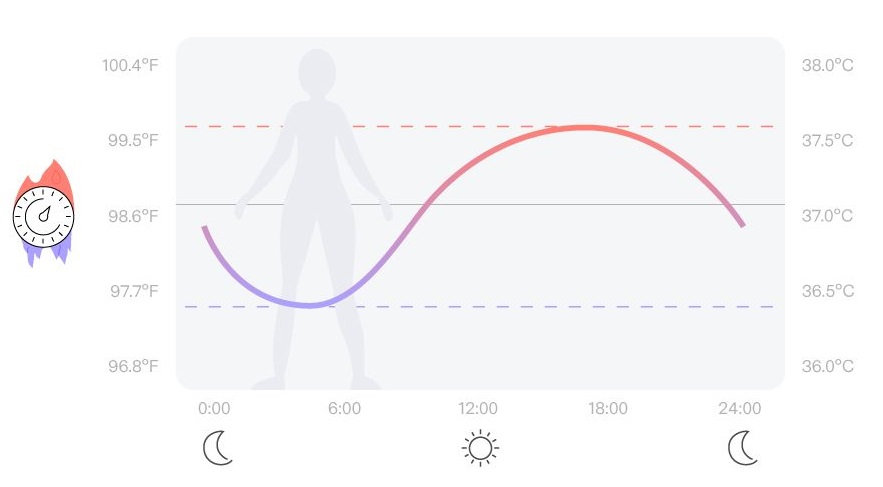- Your body’s internal thermostat maintains your core temperature close to an ideal range, adjusting through mechanisms like widening blood vessels when too hot or narrowing them when too cold.
- Core body temperature fluctuates daily in response to your circadian rhythm, with changes influenced by factors such as diet, exercise, and hormones, indicating overall health and readiness.
- Monitoring nightly core temperature with Oura can reveal crucial patterns, helping you understand how stress, illness, and other factors impact your body’s ability to recover and maintain balance.
Your body has an internal thermostat and it aims to maintain your temperature as close to your goal as possible. The stability of that number, known as your core body temperature, reflects your body’s ability to turn up the heat or cool things down to keep you within your ideal range.
Each day, your body has plans to adjust your temperature to follow your circadian rhythm by warming you up to start the day and cooling you down for sleep. Yet diet, exercise, hormones, and many other things affect your temperature. As a result, your body is constantly making adjustments to keep it all balanced:
- When you are too hot, your body tries to radiate, or get rid of heat, by widening your blood vessels to carry excess heat to your skin’s surface. As sweat evaporates off your skin and blood loses heat to the air, your body cools.
- When you are too cold, your body tries to insulate, or trap heat by narrowing your skin blood vessels so the blood keeps more heat in your core, as well as raising your temperature through shivering.
The stability of your temperature is an indicator of your body’s ability to adjust in the face of challenges. It signals how you’re recovering, how prepared you are for the day, if you’re coming down with an illness, or if hormones in your body are hard at work.
| Member Tip: Monitor your body temperature using Oura. Temperature is one of your core vital signs and a key indicator of your body’s status. Oura measures your body temperature every minute, directly from the skin of your finger—in this way, Oura is able to capture a full picture of changes in your body. |
Normal Body Temperature Fluctuations

On average, an individual’s core body temperature varies from 36.5–37.5 °C (97.7–99.5 °F) over the course of a day. Your body temperature doesn’t remain constant — it fluctuates according to your circadian rhythm.
Generally, this means your body temperature is at its lowest a few hours before you wake and its highest an hour or two before bed.
An individual’s core body temperature typically changes by about 1 °C (1.8 °F) between its highest and lowest points each day. Anything outside of that range indicates that something is challenging your body and preventing it from adjusting.
At the surface of your skin, where heat from your blood and cold from the environment are more intermingled, the range is typically much larger.
Your skin temperature and core temperature can even change in opposite directions throughout the day. For example, if your core temperature is too high, your body tries to cool itself by pushing blood to the skin so it can shed that excess heat. But in the case of fever, or after ovulation, both will rise similarly.
With all of these changes, it’s important to keep in mind where you’re measuring from before you compare numbers.
Which Patterns Matter?
During the day, your temperature varies as you move, eat, drink, socialize, and change your environment. Because there is so much variation in temperature throughout the day, if you want to measure your overall health status, it’s best to measure your temperature at night when your body is stable.
At night, your body’s temperature is a reflection of what happened during the day—is your body stressed outside of its ideal range or is it able to maintain your stable thermostat?
If your body temperature is outside of your normal range, your body is signaling to you that something is pushing it beyond what it can adjust for.
Look for these patterns in your nightly core temperature:
Disrupted Circadian Rhythms
Your circadian rhythm helps your body move between being awake or asleep. As part of this rhythm, your core body temperature drops near your optimal bedtime and rises again just before you wake up. Keep in mind that melatonin release helps trigger your body’s cooling process and may be easily disrupted by blue light.
If your average temperature is significantly higher or lower than average, or if it fails to change when you try to go to sleep, then your body may be stuck under strain—preventing it from flexibly adjusting throughout the night. If you fall asleep at a different time than you normally do (e.g., traveling to a new time zone), your temperature rhythms may also be misaligned.
Potential Illnesses
If you’re getting sick, even before you get a fever, your body’s temperature may rise. While estimates vary, normal daily temperature fluctuation is around 1 °C (1.8 °F). If you spot a high temperature outside of that range, it may mean your body is fighting to keep you healthy. Some illnesses may even cause a fever. Regardless, a positive sign of recovery is your temperature returning to normal afterward.
| Member Tip: Spot sickness before it slows you down. Oura’s Symptom Radar feature can help you detect signs that you may be getting sick, so you can proactively prioritize rest and recovery. |
Internal Heat
Powering your organs can generate a lot of internal heat. If you have a large meal or a few drinks close to bed, you may find that your temperature remains elevated throughout the night. This is evidence that your digestive system is working overtime.
You may spot changes around 0.5 °C (0.9 °F). Being in touch with your body can help you identify if overheating is due to something you can control (e.g., mealtimes or bedding) or is the result of another bodily change (e.g., hot flashes or melatonin).
Menstrual Cycles
If you track your menstrual cycle, you may see your temperature range shift with your hormones. This usually results in lower body temperatures during the first half of the menstrual cycle (follicular phase), followed by a rise in the second half (luteal phase). Note that using hormonal birth control may suppress monthly temperature variation and/or increase your average temperature.
| Member Tip: Track your menstrual cycle on Oura using Cycle Insights. You may notice that your temperature is higher during the luteal phase. |
READ MORE: How to Use Oura Temperature Trends to Track Your Cycle
Things to Keep in Mind
You have the power to influence your body temperature more than you might think. There are even Tibetan monks who meditate and raise their skin temperature high enough to dry a wet towel resting on their backs. We recommend starting with some of these simpler hacks:
- A hot shower can encourage your body to rapidly cool itself afterward, signaling to your internal thermostat, “It’s time for bed.”
- A cold shower can stimulate your system and cue your body to heat itself to stay awake.
- A cool room can lighten your body’s workload by making it easier to maintain an ideal temperature during sleep. Regardless of your temperature preferences, physiology, and science both point to the ideal nighttime room temperature being around 65 degrees Fahrenheit (18 degrees Celsius).
Observing your body’s day-to-day temperature can inform you. Start monitoring your trends and see what patterns emerge.
FAQs About Body Temperature Fluctuations
Why does my temperature go up and down?
It’s normal to notice body temperature fluctuations throughout the day. Your circadian rhythm naturally lowers your temperature before sleep and raises it before waking. Other factors — like diet, exercise, hormones, or illness — can also cause your temperature to go up and down.
What causes fluctuating body temperature at night?
Fluctuating body temperature while sleeping is often linked to your circadian rhythm, digestion after a late meal, alcohol, or hormonal changes. Illness, stress, or hot flashes can also contribute. Tracking your nightly temperature patterns can help reveal what’s behind these shifts.
Are hot and cold body temperature swings a health concern?
Occasional hot and cold body temperature swings are usually normal, but persistent or extreme swings may indicate strain on your body. Illness, infections, or misaligned circadian rhythms can all cause abnormal changes. If your temperature stays outside your normal range, it may be worth discussing with a healthcare provider.
How can I monitor body temperature fluctuations?
You can track body temperature fluctuations by measuring at the same time each day or using a wearable device like Oura. Nightly temperature monitoring provides the most consistent baseline, helping you spot changes related to stress, recovery, illness, or your menstrual cycle.




